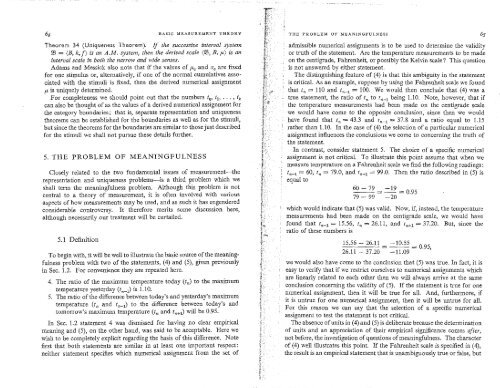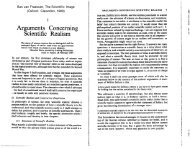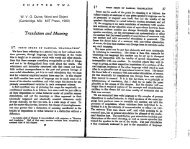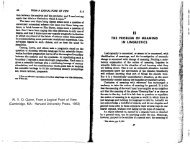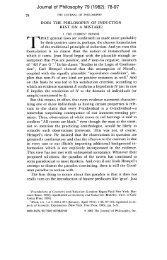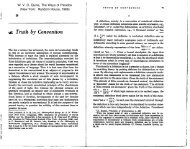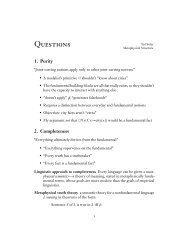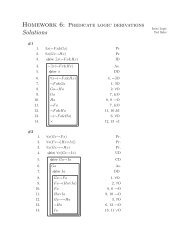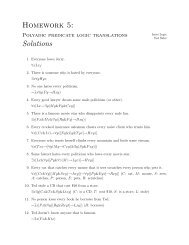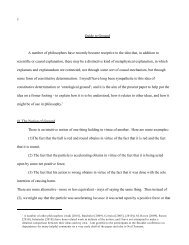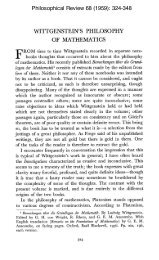Suppes and Zinnes - basic measurement theory.pdf - Ted Sider
Suppes and Zinnes - basic measurement theory.pdf - Ted Sider
Suppes and Zinnes - basic measurement theory.pdf - Ted Sider
You also want an ePaper? Increase the reach of your titles
YUMPU automatically turns print PDFs into web optimized ePapers that Google loves.
BASIC MEASUREMENT THEORY<br />
Theorem 34 (Uniqueness Theorem). If the successive interval system<br />
il3 = (B, k,f) is an A.M. system, then the derived scale (iB, R, !") is an<br />
interval scale in both the narrow <strong>and</strong> wide senses.<br />
Adams <strong>and</strong> Messick also note that if the values of f.i-a <strong>and</strong> ua are fixed<br />
for one stimulus or, alternatively, if one of the normal cumulatives associated<br />
with the stimuli is fixed, then the derived numerical assignment<br />
p is uniquely determined.<br />
For completeness we should point out that the numbers t 0 , tb ... , tk<br />
can also be thought of as the values of a derived numerical assignment for<br />
the category boundaries; that is, separate representation <strong>and</strong> uniqueness<br />
theorems can be established for the boundaries as well as for the stimuli,<br />
but since the theorems for the boundaries are similar to those just described<br />
for the stimuli we shall not pursue these details further.<br />
5. THE PROBLEM OF MEANINGFULNESS<br />
Closely related to the two fundamental issues of <strong>measurement</strong>-the<br />
representation <strong>and</strong> uniqueness problems-is a third problem which we<br />
shall term the meaningfulness problem. Although this problem is not<br />
central to a <strong>theory</strong> of <strong>measurement</strong>, it is often involved with various<br />
aspects of how <strong>measurement</strong>s may be used, <strong>and</strong> as such it has engendered<br />
considerable controversy. It therefore merits some discussion here,<br />
although necessarily our treatment will be curtailed.<br />
5.1 Definition<br />
To begin with, it will be well to illustrate the <strong>basic</strong> source of the meaningfulness<br />
problem with two of the statements, (4) <strong>and</strong> (5), given previously<br />
in Sec. 1.2. For convenience they are repeated here.<br />
4. The ratio of the maximum temperature today (tJ to the maximum<br />
temperature yesterday (tn_ 1 ) is 1.10.<br />
5. The ratio of the difference between today's <strong>and</strong> yesterday's maximum<br />
temperature Ctn <strong>and</strong> tn-J to the difference between today's <strong>and</strong><br />
tomorrow's maximum temperature Ctn <strong>and</strong> tn+1) will be 0.95.<br />
In Sec. 1.2 statement 4 was dismissed for having no clear empirical<br />
meaning <strong>and</strong> (5), on the other h<strong>and</strong>, was said to be acceptable. Here we<br />
wish to be completely explicit regarding the basis of this difference. Note<br />
first that both statements are similar in at least one important respect:<br />
neither statement specifies which numerical assignment from the set of<br />
THE PROBLEM OF MEANINGFULNESS<br />
admissible numerical assignments is to be used to determine the validity<br />
or truth of the statement. Are the temperature <strong>measurement</strong>s to be made<br />
on the centigrade, Fahrenheit, or possibly the Kelvin scale? This question<br />
is not answered by either statement.<br />
The distinguishing feature of ( 4) is that this ambiguity in the statement<br />
is critical. As an example, suppose by using the Fahrenheit scale we found<br />
that tn = 110 <strong>and</strong> 1n_ 1 = 100. We would then conclude that (4) was a<br />
true statement, the ratio of tn to tn_ 1 being 1.10. Note, however, that if<br />
the temperature <strong>measurement</strong>s had been made on the centigrade scale<br />
we would have come to the opposite conclusion, since then we would<br />
have found that tn = 43.3 <strong>and</strong> tn-l = 37.8 <strong>and</strong> a ratio equal to 1.15<br />
rather than 1.10. In the case of (4) the selection of a particular numerical<br />
assignment influences the conclusions we come to concerning the truth of<br />
the statement.<br />
In contrast, consider statement 5. The choice of a specific numerical<br />
assignment is not critical. To illustrate this point assume that when we<br />
measure temperature on a Fahrenheit scale we find the following readings:<br />
tn_ 1 = 60, tn = 79.0, <strong>and</strong> tn+ 1 = 99.0. Then the ratio described in (5) is<br />
equal to<br />
60- 79 = -19 = 0.95<br />
79- 99 -20<br />
which would indicate that (5) was valid. Now, if, instead, the temperature<br />
<strong>measurement</strong>s had been made on the centigrade scale, we would have<br />
found that tn_ 1 = 15.56, tn = 26.11, <strong>and</strong> tn+ 1 = 37.20. But, since the<br />
ratio of these numbers is<br />
15.56- 26.11 = -10.55 = 0.95,<br />
26.11- 37.20 -11.09<br />
we would also have come to the conclusion that (5) was true. In fact, it is<br />
easy to verify that if we restrict ourselves to numerical assignments which<br />
are linearly related to each other then we will always arrive at the same<br />
conclusion concerning the validity of (5). If the statement is true for one<br />
numerical assignment, then it will be true for all. And, furthermore, if<br />
it is untrue for one numerical assignment, then it will be untrue for all.<br />
For this reason we can say that the selection of a specific numerical<br />
assignment to test the statement is not critical.<br />
The absence of units in (4) <strong>and</strong> (5) is deliberate because the determination<br />
of units <strong>and</strong> an appreciation of their empirical signiHcance comes after,<br />
not before, the investigation of questions of meaningfulness. The character<br />
of (4) well illustrates this point. If the Fahrenheit scale is specified in (4),<br />
the result is an empirical statement that is unambiguously true or false, but


